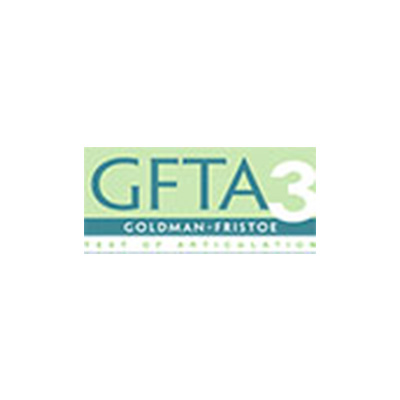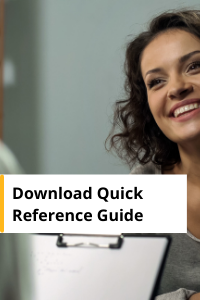Ronald Goldman, PhD, Macalyne Fristoe, PhD
Overview:The third edition of the Goldman-Fristoe Test of Articulation offers updated norms, new digital test administration and scoring options. The new test will still be brief to administer and easy to score, while providing you with accurate scores you can count on for making diagnostic and placement decisions.
Age Range:2:0 - 21:11
RTI Tiers:RTI Levels 1, 2 and 3
Completion Time:5 to 15 minutes for Sounds-in-Words Section, varied for Sounds-In-Words, Intelligibility, and Stimulability sections
Telepractice:Tips on using this test in your telepractice
Norms:New norms have been expanded to include ages 2-21 with separate normative tables for males and females.
Digital Choices:New digital options, including Q-interactive and Q-global administration and scoring
Publication Date:2015
Updates to the most popular articulation test
The third edition of the Goldman-Fristoe Test of Articulation offers updated norms, new digital test administration and scoring options. The new test will still be brief to administer and easy to score, while providing you with accurate scores you can count on for making diagnostic and placement decisions.
New Features
- Digital administration and on-the-fly scoring on Q-interactive (see helloQ.com)
- Digital manuals and digital stimulus book available, as well as automated scoring on Q-global
- Assess multiple occurrences of high frequency phonemes in the same amount of time (under 15 minutes)
- Dialect-sensitive scoring for a wide range of American English dialects as well as English influenced by another language
- New criterion-referenced assessment of vowels
- Two new art sets, one appropriate for very young children and one for older students with articulation and intelligibility concerns
- Based on over 40 years of research, with current normative data
Digital Options Available
Q-interactive
Q-interactive is Pearson’s web- and iPad-based system for interactive, seamless assessment, scoring, and reporting. With Q-interactive, administer interactive assessments with an intuitive, portable system that uses two iPads connected by Bluetooth. The examinee views test stimuli on one iPad; you use the other iPad to access test administration directions and verbal stimuli, control visual stimuli, and record and score responses.
Your Q-interactive yearly speech license includes access to five assessments: GFTA-3, KLPA-3, GFTA-3 Spanish, CELF-5, and PPVT-4. You purchase individual test administrations.
Try Q-interactive for free with our 30 day trial. Learn more at HelloQ.com
Q-global
Q-global is Pearson’s web-based system for accessing digital resources for assessment, scoring, and reporting. Use any web-enabled computer or tablet–ideal for face-to-face or telepractice assessments!
A GFTA-3 Digital Kit is available (including a digital stimulus book, digital manual, and paper record forms). Scoring is purchased separately. You have the option to purchase an unlimited-use 1-, 3-, or 5- year scoring subscription or individual score reports. Quantity discounts are available.
Important note: Each scoring subscription is per user and will begin on the date the first subscription from the order is allocated to the user(s) in the Q-global account.
When your order for the GFTA-3 , has been processed, you will receive an email informing you that your GFTA-3 digital Manual, Stimulus Book, and/or scoring are available on the Q-global platform. The paper Record Forms included in the Digital Kit will be will be shipped to you.
Two options for scoring and reporting the GFTA-3 are now available on Q-global.
The first option is to pay per-report. Customers who administer the GFTA-3 only a few times each year, or those who want the flexibility to pay only as the assessment is used, may prefer this option.
The second option is to select an “unlimited use” subscription, where one user of the GFTA-3 gets unlimited scoring and reporting for one, three, or five years depending on the selected term of the subscription. This may be a better option for customers who administer the GFTA-3 several times each year—and don’t want to worry about keeping track of their report expenses.
In addition to manual scoring, GFTA-3 will be available on Q-global™, Pearson’s web-based scoring and reporting platform.
Q-global offers:
- 24/7 secure, web-based access
- Portability: Q-global can be used on mobile devices such as a laptop or tablet
- On-demand, reliable scoring and comprehensive reporting solutions
- Pricing on a per-report basis
GFTA-3 Score Reports
- Automatically converts total raw scores to test scaled scores, percentile ranks, age equivalents, and growth scale values
- Automatically converts sums of scaled scores to composites scores, including the Core Language and numerous index scores
- Provides an item analysis of performance on individual test
Materials
GFTA-2/GFTA-3 Comparison Flyer
GFTA-3 Print and Digital Options
Pre-recorded Webinars
-
Using Digital Assessments to Evaluate Speech and Language Skills
Presenter: James Henke and Jarett Lehner

Many of today’s students are “digital natives” who are attentive and engaged with presented with digital input. Digital assessments can provide streamlined test administration that is engaging for examinees, while automated scoring and reporting improves examiner efficiency and provides accurate test scores. This session will introduce clinicians to digital assessments available, compare assessment formats on Q-interactive and Q-global and provide an overview of the research supporting the equivalence of test results whether the test is delivered on paper or in a digital format.
Date: Nov 02, 2017
 PDF: Using Digital Assessments to Evaluate Speech and Language Skills
PDF: Using Digital Assessments to Evaluate Speech and Language Skills Video: Using Digital Assessments to Evaluate Speech and Language Skills
Video: Using Digital Assessments to Evaluate Speech and Language Skills -
Transitioning From GFTA-2 to GFTA-3: Interpreting & Communicating Test Results
Presenter: Chien (Shannon) Wang, M.A. Senior Research Director

GFTA-2/GFTA-3 scores may differ significantly, especially with children exhibiting certain error patterns. GFTA-3 research data showing age of emergence vs. mastery of speech sounds, combined with test scores, provide clinicians with data needed to make appropriate interpretations of test results and convey results in a meaningful way to stakeholders.
Date: Sep 13, 2017
 PDF: Transitioning From GFTA-2 to GFTA-3: Interpreting & Communicating Test Results
PDF: Transitioning From GFTA-2 to GFTA-3: Interpreting & Communicating Test Results Video: Transitioning From GFTA-2 to GFTA-3: Interpreting & Communicating Test Results
Video: Transitioning From GFTA-2 to GFTA-3: Interpreting & Communicating Test Results -
Overview of GFTA-3 Spanish Administration, Scoring and Interpretation
Presenter: Marie Sepulveda, MA CCC-SLP

This webinar will provide a review of administration and scoring of the Goldman-Fristoe Test of Articulation, 3rd Edition Spanish (GFTA-3 Spanish) as well as an overview of the research base and psychometric characteristics of the GFTA-3 Spanish. Discussion will include developmental considerations when interpreting GFTA-3 Spanish results.
Date: Apr 12, 2017
 PDF: Overview of GFTA-3 Spanish Administration, Scoring and Interpretation
PDF: Overview of GFTA-3 Spanish Administration, Scoring and Interpretation Video: Overview of GFTA-3 Spanish Administration, Scoring and Interpretation
Video: Overview of GFTA-3 Spanish Administration, Scoring and Interpretation -
Overview of the Goldman-Fristoe Test of Articulation 3 (GFTA-3)
Presenter: Shannon Wang, MA, CCC-SLP

The Goldman-Fristoe Test of Articulation, 3rd Edition (GFTA-3) is the most widely used articulation assessment in the U.S. This course provided a review of new administration and scoring procedures, as well as an overview of the new normative data and psychometric characteristics of the GFTA-3. Discussion included developmental considerations when interpreting GFTA-3 results.
Date: Aug 25, 2015
Questions
Frequently asked questions follow. Click on a question to see the response.
Choosing a Picture Set
- Can you use either the cartoon pics or the realistic pics with any age and can still use the standard scores?
Test Items
- What happened to blends /fl/ and /kl/?
- Why is the word “yellow” tested when none of my clients can produce this word correctly–they always say “lello” or “yeyo”.
- Why isn’t the medial voiceless /th/ and the medial “j” as in orange tested?
- On GFTA-3, is the vowelized r (like in the word “card”) addressed separately from vowelized (like the word “Mary”)
Sounds-in-Sentences
- Is it OK to use the younger age story for Sounds-in-Sentences with lower-cognitive-ability students?
- Why are Sounds-in-Sentences scores sometimes higher than the Sounds-in-Words scores?
- Why are the standard scores so much lower on the Sounds-in-Words and Sounds-in-Sentences tests in a case where a 7-year-old girl misses every /r/ on both tasks?
Record Form
- Is there any chance that the test protocol will be altered to make it more user friendly is sharing data and results with the parents?
Distortions
- Do “r” and “s” distortions count as errors?
- How do you score a production in which the child presents with a forward tongue protrusion/tongue thrust?
Tongue Thrust
- How do you take into account if a child presents with a forward tongue protrusion / tongue thrust?
- If a child has a significant number of dentalized errors (due to tongue thrusting) on the GFTA-3, do these errors count toward the raw score or are they only noted on the form, but not counted as a raw score error? In other words, are the dentalized errors considered a diacritical mark and therefore, not counted in the raw score or are the dentalized sounds considered a distortion and therefore counted in the raw score?
Frequency of /s, l, r/ on GFTA-3
- Why does GFTA-3 penalize preschoolers by giving them so many /s, l, r/ occurrences. This is problematic. They are not penalized as heavily for /k, g, f/ errors which we would expect in many of our preschoolers.
Dialectal Variations
- Are there different norms tables for examinees who speak a variation of English? And if so, are there tables describing dialectical differences in the manual?
- Are dialectal variations counted as errors? That is what it says on the slides posted online.
Sound Additions
- How should we account for sound additions? If a child says “drump” for “drum,” do we count the final /m/ correct or incorrect? Q-global does not allow us to account for sound additions.
Higher GFTA-2 scores than GFTA-3
- How can a child’s score on GFTA-2 be so different on GFTA-3?
Emergence vs Mastery of Speech Sounds
- Please explain the criterion applied to indicate “emergence” vs. “mastery” of speech sounds.
- The developmental chart I use shows the ages of speech sound mastery as different from both Tables D1 and D2. Why is that?
- On Table D.1, is it saying that 90% of students master R in the 2-6 to 2-11 age range or just beginning to make R sounds?
GFTA-3 Research
- Were there any bilingual speakers included in the norming sample (i.e., non-monolingual English speakers)? Were these children exposed to English from birth or was there a variety of first language exposure?
KLPA-3
- Will there be a KPLA-3 to accompany the GFTA-3?
Digital Options
- Could you give a brief overview of the differences in the types of digital/electronic scoring?
- How should we account for sound additions on Q-global? If a child says “drump” for “drum,” do we count the final /m/ correct or incorrect?
- Q-global does not have a place to notate additions of sounds.
Converting from GFTA-2 to GFTA-3
- How long of a time period can a clinician use GFTA-2 because switching to GFTA-3?
Benefits of GFTA-3 on Q-interactive
- Easy-to-use phonetic keypad for recording examinee’s speech sound errors
- Engage children by displaying stimuli on the iPad.
- Listen to your client’s responses after the assessment session via our audio recording feature.
- Automatically generate score reports and purchase the KLPA-3 phonological analysis with the click of a button!
- Create a custom battery by combining the GFTA-3 with other tests such as the CELF-5 and PPVT-4.
- Obtain scaled scores immediately after finishing a subtest, to increase scoring speed and accuracy.










